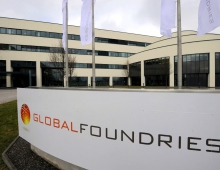
GLOBALFOUNDRIES to Showcase Design Solutions for 28nm and Beyond at DAC 2011
At next week's 48th Design Automation Conference (DAC) in San Diego, Calif., GLOBALFOUNDRIES will demonstrate how its approach to ecosystem collaboration has helped deliver the comprehensive design platform for advanced technologies.
The company will feature a full complement of design infrastructure for its 28nm High-k Metal Gate (HKMG) technology, including silicon-validated flows, process design kits (PDKs), design-for-manufacturing (DFM), and intellectual property (IP) from leading companies. GLOBALFOUNDRIES will also showcase approaches to overcoming new design challenges as the industry moves to 20nm and beyond.
GLOBALFOUNDRIES' 28nm HKMG technology leverages learning from a high-volume ramp on 32nm HKMG technology. The company is expected to ship more HKMG volume in 2011 than all other foundries combined. The 28nm technology, which is optimized for SoC-based mobile devices, uses the same 32nm HKMG implementation that has now reached volume production.
"This "Gate First" approach to 28nm technology offers longer battery life for mobile products with higher performance and lower cost, while providing the full entitlement of scaling from the 45/40nm node, with a 10-20% cost saving over HKMG solutions offered by other foundries," GLOBALFOUNDRIES said in a statement.
"At GLOBALFOUNDRIES, we have been in production of real HKMG products for months," said Mojy Chian, senior vice president of design enablement at GLOBALFOUNDRIES. "We have been leveraging this experience by collaborating with ecosystem partners to build this knowledge into the design infrastructure and tools we provide to customers at 28nm. This focus on early design-technology co-optimization and silicon validation will translate to accelerated time-to-market for the next generation of power-sensitive consumer electronics and mobile devices."
GLOBALFOUNDRIES' 28nm HKMG technology is fully enabled and ready for design-in today with a complete set of libraries, compilers, and complex IP. The company has collaborated with companies in the EDA/IP ecosystem to deliver both digital and Analog Mixed-Signal (AMS) design flows for its 28nm HKMG technology.
"Tuned to help overcome the challenges of designing and manufacturing at advanced nodes, the signoff-ready flows were developed with recognition of the need for silicon validation to ensure first-time-right success. GLOBALFOUNDRIES has addressed the growing interaction of design and manufacturing by emphasizing early collaborative development with providers of EDA software and IP to validate design methodologies against real silicon. All 28nm flows support DRC+, the company's silicon-validated solution that goes beyond standard Design Rule Checking (DRC) and uses two-dimensional shape-based pattern-matching to enable fast identification of manufacturing issues," the company added.
As the industry approaches the 20nm node, new physical design rules as a result of more complex lithography and manufacturing challenge traditional methods for node-to-node area scaling while enabling a fast yield ramp and cost efficiency. GLOBALFOUNDRIES has developed a set of special constructs to be used inside standard cells or in custom design to overcome these restrictions and reduce cell area. These fixed structures use fully qualified context-aware design rules that are proven to yield through printability simulation and test chip results. GLOBALFOUNDRIES uses these constructs along with rule-based, model-based and pattern-based DFM. Whereas DFM can be thought of as feedback from manufacturing to design, GLOBALFOUNDRIES also has pioneered new approaches to Design-Enabled Manufacturing (DEM), which includes feeding forward information from design to manufacturing. Both techniques complement each other and are required to continue innovation at 20nm and beyond.
GLOBALFOUNDRIES' 28nm HKMG technology leverages learning from a high-volume ramp on 32nm HKMG technology. The company is expected to ship more HKMG volume in 2011 than all other foundries combined. The 28nm technology, which is optimized for SoC-based mobile devices, uses the same 32nm HKMG implementation that has now reached volume production.
"This "Gate First" approach to 28nm technology offers longer battery life for mobile products with higher performance and lower cost, while providing the full entitlement of scaling from the 45/40nm node, with a 10-20% cost saving over HKMG solutions offered by other foundries," GLOBALFOUNDRIES said in a statement.
"At GLOBALFOUNDRIES, we have been in production of real HKMG products for months," said Mojy Chian, senior vice president of design enablement at GLOBALFOUNDRIES. "We have been leveraging this experience by collaborating with ecosystem partners to build this knowledge into the design infrastructure and tools we provide to customers at 28nm. This focus on early design-technology co-optimization and silicon validation will translate to accelerated time-to-market for the next generation of power-sensitive consumer electronics and mobile devices."
GLOBALFOUNDRIES' 28nm HKMG technology is fully enabled and ready for design-in today with a complete set of libraries, compilers, and complex IP. The company has collaborated with companies in the EDA/IP ecosystem to deliver both digital and Analog Mixed-Signal (AMS) design flows for its 28nm HKMG technology.
"Tuned to help overcome the challenges of designing and manufacturing at advanced nodes, the signoff-ready flows were developed with recognition of the need for silicon validation to ensure first-time-right success. GLOBALFOUNDRIES has addressed the growing interaction of design and manufacturing by emphasizing early collaborative development with providers of EDA software and IP to validate design methodologies against real silicon. All 28nm flows support DRC+, the company's silicon-validated solution that goes beyond standard Design Rule Checking (DRC) and uses two-dimensional shape-based pattern-matching to enable fast identification of manufacturing issues," the company added.
As the industry approaches the 20nm node, new physical design rules as a result of more complex lithography and manufacturing challenge traditional methods for node-to-node area scaling while enabling a fast yield ramp and cost efficiency. GLOBALFOUNDRIES has developed a set of special constructs to be used inside standard cells or in custom design to overcome these restrictions and reduce cell area. These fixed structures use fully qualified context-aware design rules that are proven to yield through printability simulation and test chip results. GLOBALFOUNDRIES uses these constructs along with rule-based, model-based and pattern-based DFM. Whereas DFM can be thought of as feedback from manufacturing to design, GLOBALFOUNDRIES also has pioneered new approaches to Design-Enabled Manufacturing (DEM), which includes feeding forward information from design to manufacturing. Both techniques complement each other and are required to continue innovation at 20nm and beyond.




















